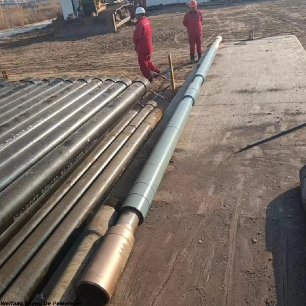A drilling jar is an essential downhole tool used in drilling operations to deliver a powerful impact that helps free stuck drill strings or other downhole assemblies. This tool plays a critical role in maintaining operational efficiency and preventing costly delays when drilling encounters stuck pipe situations. The activation process is not just about pulling or pushing; it involves understanding the jar's mechanism, the downhole conditions, and the correct timing for impact. Knowing how to activate a drilling jar effectively can mean the difference between a quick resolution and prolonged downtime, tool damage, or even a complete drilling halt.
Drilling Jar in Drilling Operations
In drilling operations, situations often arise where the drill string becomes lodged in the borehole due to factors such as differential sticking, cuttings accumulation, or borehole instability. A drilling jar is specifically designed to release this stuck assembly by delivering a sudden, controlled jolt. Unlike surface pulling or rotation alone, the drilling jar's impact can break the sticking force more efficiently, especially in deep wells where surface efforts lose their effectiveness.
The jar works by storing energy in the drill string and then suddenly releasing it, creating an impact force. Depending on the type of jar, this can be done in an upward direction, a downward direction, or both. When used correctly, a drilling jar not only speeds up the freeing process but also reduces the risk of damaging the drill string, bottom hole assembly (BHA), and other downhole tools.
Because drilling operations can cost thousands of dollars per hour, the ability to quickly and safely activate a drilling jar has direct financial benefits. This is why understanding its operation is a crucial skill for drillers, toolpushers, and directional drilling teams.
Why Activation Method Matters
The activation method is closely linked to the success rate of freeing stuck pipe and the overall lifespan of the drilling jar. Applying the wrong type or amount of force can lead to several issues:
Insufficient impact may fail to break the stuck condition, causing wasted time and repeated attempts.
Excessive force can damage the jar's internal components, leading to costly repairs or replacement.
Improper timing may cause premature activation, reducing the jar's effectiveness when the force is needed most.
Additionally, the downhole environment—such as pressure, temperature, and wellbore geometry—can significantly influence activation performance. Proper activation is therefore a blend of mechanical skill, situational awareness, and experience.
Understanding Drilling Jar Activation
The basic principle behind drilling jar activation is to store energy in the drill string and then release it suddenly. This stored energy is usually applied by pulling upward (tension) or pushing downward (compression) on the drill string. When the jar's trigger mechanism releases, this energy is converted into an impact at the point of sticking.
There are two main types of activation principles:
Hydraulic Activation – Uses hydraulic fluid inside the jar to delay the release of stored energy. This allows the driller to apply a controlled preload before the jar fires. Hydraulic jars provide precise timing but can be affected by temperature and fluid viscosity.
Mechanical Activation – Relies on mechanical latch and release systems. Mechanical jars react more quickly but may offer less control over timing compared to hydraulic types.
The choice between hydraulic and mechanical activation often depends on well conditions, operational preference, and the type of drilling program.
Types of Activation Mechanisms
Upward Activation (Up Jarring)
In upward activation, the driller pulls on the drill string, applying tension until the jar triggers and delivers an upward impact. This method is typically used when the stuck point is holding the drill string from above, such as in differential sticking or when debris has settled around the drill collars.
Downward Activation (Down Jarring)
In downward activation, the driller pushes down on the drill string, creating compression. When the jar releases, the stored force is delivered downward, useful when the stuck point is below the jar or in cases where the obstruction needs to be driven downward.
Bi-Directional Activation
Some advanced drilling jars are designed for both upward and downward activation. This flexibility allows drillers to choose the most effective direction of impact without changing tools, making them highly valuable in complex well conditions.
Step-by-Step Activation Process
Identify the Stuck Point and Impact Direction
Accurate identification of where and why the drill string is stuck is critical. This is usually determined through weight-on-bit readings, torque analysis, and downhole telemetry.
Apply Preload (Tension or Compression)
The driller gradually applies the necessary pulling or pushing force to the drill string. This preload stores energy in the pipe, which will be released as impact.
Wait for the Delay Mechanism to Engage
For hydraulic jars, this step allows the internal fluid to move through a metered passage, creating a delay before firing. Mechanical jars may require movement past a latch point.
Impact and Reset
Once released, the jar delivers a powerful blow in the selected direction. After firing, the jar resets, ready for another activation if necessary.
Factors Affecting Activation
Well Depth and Downhole Pressure
Greater depths increase the drill string's weight and elastic stretch, which can influence both preload requirements and the jar's performance.
Temperature Effects on Hydraulic Oil
In hydraulic jars, extreme temperatures can change fluid viscosity, altering the delay timing and force output.
Magnitude and Duration of Applied Load
Too little load may not achieve the necessary impact, while excessive load risks damaging both the jar and the drill string.
Mud Properties
Drilling fluid density, viscosity, and flow rate can impact jar movement and reset efficiency.
Best Practices for Safe and Effective Activation
Avoid Overloading – Follow manufacturer guidelines on maximum pull or push force to prevent tool failure.
Use Proper Timing – Allow the jar's delay system to function fully before attempting another activation.
Coordinate with Other Tools – When used alongside fishing tools, shock tools, or other BHA components, ensure compatibility and safe load limits.
Document Tool Performance – Keeping activation logs can help fine-tune future jar usage in similar well conditions.
Regular Maintenance – A well-maintained jar will perform more consistently and last longer.
Common Mistakes to Avoid
Insufficient or Excessive Preload – Misjudging the correct force can either reduce impact effectiveness or cause damage.
Ignoring Downhole Changes – Failing to adapt activation strategy when formation, pressure, or hole size changes can waste time.
Skipping Maintenance Checks – Neglecting pre-job inspections can lead to malfunction at critical moments.
Relying on a Single Activation Direction – In some cases, alternating between upward and downward impacts can be more effective.
Conclusion
Activating a drilling jar is not just about applying force—it requires a precise combination of tool expertise, operational skill, and awareness of downhole conditions. By choosing the right activation method, setting the correct preload, and avoiding common mistakes, drillers can greatly enhance the jar's performance while safeguarding other valuable equipment. Mastering this process not only increases the chances of freeing stuck pipe but also leads to safer, faster, and more cost-effective drilling operations.
If you want to learn more about proper drilling jar activation or explore reliable, high-quality oilfield tools, Weifang Shengde Petroleum Machinery Manufacturing Co., LTD is an excellent resource. With extensive experience in petroleum equipment manufacturing and a strong reputation for quality, they can provide both technical guidance and durable products tailored to your needs. For detailed information or professional consultation, consider reaching out to them directly—you'll gain valuable insights and solutions for your next drilling project.















